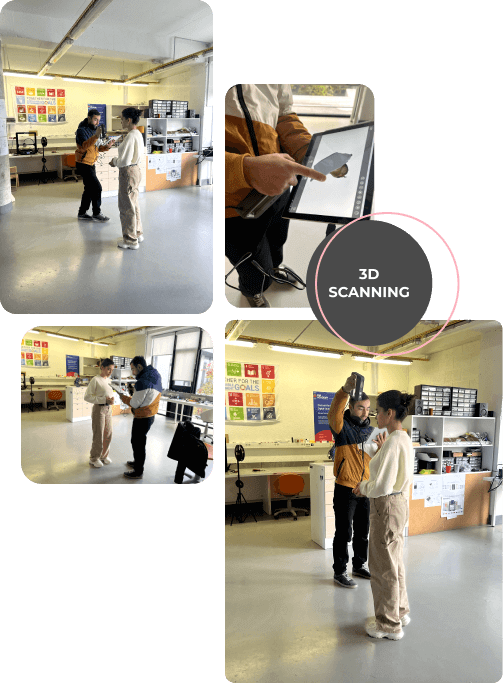1. State of the Art: Project Management and Documentation¶
Inspiration for Fabricademy¶
During my journey through Fabricademy, I drew inspiration from various artists, scientists, and design pioneers whose work bridges the realms of technology, art, and sustainability. The key sources of my inspiration include:
-
Nature’s Patterns and Biomimicry: Observing natural structures, like the intricate design of leaves, the geometry of honeycombs, and the strength of seashells, has inspired my approach to creating biomaterials and sustainable designs. The resilience and efficiency found in nature inform how I think about constructing textiles that are both beautiful and functional.
-
Artists and Visionaries:
- Neri Oxman: has been an immense influence with her work at the intersection of biology and design, showcasing the possibilities of creating new materials that adapt to the environment. Her projects that integrate living organisms into fabric constructions sparked my interest in bio-fabrication and my exploration of growing materials.

- Behnaz Farahi: as a significant source of inspiration for me due to her pioneering integration of fashion, technology, and interactive design. Her creations push the boundaries of wearable technology by incorporating sensors, movement, and 3D-printed elements that respond to the wearer or environment. This blend of art and science embodies the essence of innovation, encouraging me to explore the possibilities within digital fabrication and smart textiles for my own projects at Fabricademy.

-
Technology in Fabrication: My exposure to advancements in digital fabrication and wearable technology pushed me to leverage modern tools such as 3D printers, laser cutters, and electronic textiles in my projects. The integration of these technologies allowed me to reimagine how traditional textiles could be developed with adaptive and responsive qualities.
-
Scientific Research and Material Experimentation: My background in chemistry and design has enabled me to conduct hands-on research with natural fibers, bio-based resins, and composite materials. This aspect of exploration has been key in understanding the properties of materials and how they can be adapted to innovative design solutions.
These inspirations have shaped my projects at Fabricademy, driving me to push the boundaries of traditional design methods and integrate sustainable practices that highlight both art and science.
Documentation Workflow¶
In our first week, we familiarized ourselves with various platforms to document our work and facilitate communication. These include:
- Fablabs.io: A global network of labs.
- GitLab: Hosting our documentation websites.
- NuEval: For evaluations and feedback.
- Mattermost: For communication on assignments.
We also learned about visual documentation and how to build personal websites. This process involves understanding HTML and Markdown, which helps us create user-friendly documentation.
To document and manage my Fabricademy project effectively, I learned how to upload images, videos, references, and utilize Markdown and GitLab. This process was crucial for creating a comprehensive and engaging project page. By mastering Markdown, I was able to structure content with headings, lists, and emphasis, making my documentation readable and professional. Integrating multimedia elements such as images and videos enriched my project presentation, showcasing my work in a visually appealing way.
GitLab provided a collaborative platform that allowed me to version-control my documentation, ensuring that any updates or changes were tracked efficiently. Through this process, I gained confidence in using Git commands and uploading files, which supported my ability to maintain and share my project effectively with the Fabricademy community.
Getting Started with Coding¶
Initially intimidated by web development, I learned that:
- A website is built on HTML code.
- Markdown simplifies the editing process.
- CSS enhances styling beyond templates.
Using Markdown for Documentation¶
Markdown is a lightweight markup language that makes it easy to format text for the web. It is widely used for project documentation, including adding images, videos, and references. Below are examples of how to use Markdown effectively:
- Headings Markdown allows you to create headings using the # symbol. The number of # symbols corresponds to the heading level.
# Main Heading
## Subheading
### Sub-subheading
- Formatting Text To emphasize text, you can use:
Bold: **This is bold text**
Italic: *This is italic text*
Bold and Italic: **_This is bold and italic text_**
- Adding Images To upload and display an image in Markdown:

Using GitLab for Version Control¶
GitLab allows you to version control your documentation by pushing changes to a repository. Basic Git commands for working with GitLab include:
- Cloning a Repository:
git clone https://gitlab.com/your_username/your_project.git
- Committing Changes:
git commit -m "Added new content"
- Pushing to GitLab:
git push origin main
Final Steps in GitLab¶
- Upload Images/Videos: Drag and drop or use Git commands to upload media files to your project repository.
- Edit Documentation: Use the GitLab Markdown editor to make changes or create new Markdown files.
- Version Control: Keep track of your changes with Git commits and review your version history on GitLab.
This workflow helps ensure that your project documentation is organized, visually appealing, and well-managed.
Tools Utilized¶
- Markdown
- MkDocs
- Jekyll
- TinyPNG
CSS Customization¶
I learned to edit CSS for enhanced styling, including:
- Changing colors, open stylesheets and go to extra.css and your custom css codes there.
:root {
--md-primary-fg-color: #4a4a4a;
--md-accent-color: #ff4081;
--light-pink: #ffb3c1;
--md-accent-fg-color: var(--light-pink);
--link: #eee;
}
- Centering images.
{ width=80% style="display: block; margin: 0 auto" }
- Centering Videos.
<iframe width="560" height="315" src="https://www.youtube.com/embed/DiktI67OJ_Y?si=splOcatPxlkfpXV_" title="YouTube video player" frameborder="0" allow="accelerometer; autoplay; clipboard-write; encrypted-media; gyroscope; picture-in-picture; web-share" referrerpolicy="strict-origin-when-cross-origin" allowfullscreen class="iframe-youtube"></iframe>
This journey is just beginning, and I look forward to exploring the intersections of technology, art, and design.